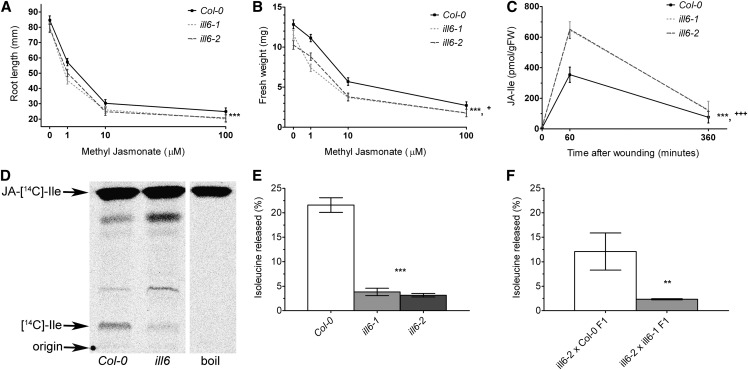Figure 4.
ILL6 Negatively Regulates JA Response and Wound-Induced JA-Ile Accumulation, Likely through Hydrolysis of JA-Ile.
(A) Response of mutant and wild-type Arabidopsis seedlings' root length to exogenous MeJA. Seedlings were exposed to media containing 0, 1, 10, or 100 µM MeJA for 8 d (n ≥ 16 seedlings).
(B) The rosettes of the plants in (A) were excised from the roots and weighed (n ≥ 16 seedlings).
(C) Time course of wound-induced JA-Ile accumulation. Plants were wounded and damaged leaves were harvested at the indicated time points after wounding and JA-Ile accumulation was analyzed by liquid chromatography–tandem mass spectrometry (n = 6 plants across two independent experiments).
(D) Representative in vivo JA-[14C]Ile hydrolysis assay. JA-[14C]Ile was applied to individual plant leaves of the indicated genotype, and extracts were separated by thin layer chromatography and visualized by autoradiography.
(E) In vivo hydrolysis of JA-[14C]Ile in ill6 mutants and the wild type. Autoradiograms were quantified by densitometry (n ≥ 9 plants across five independent experiments).
(F) ill6-1 and ill6-2 are allelic mutations. The two F1 hybrids indicated were subjected to an in vivo hydrolysis assay as in (D) and (E) (n = 3 plants).
For all plots, data represent mean ± se, and asterisks indicate significance of genotype effects: *P ≤ 0.05, **P ≤ 0.01, and ***P ≤ 0.001. The plus sign indicates P ≤ 0.05 for the genotype × MeJA interaction effect in (B), and three plus signs indicates P ≤ 0.001 for the genotype × time interaction effect in (C) (see Methods for details on statistical analyses).

